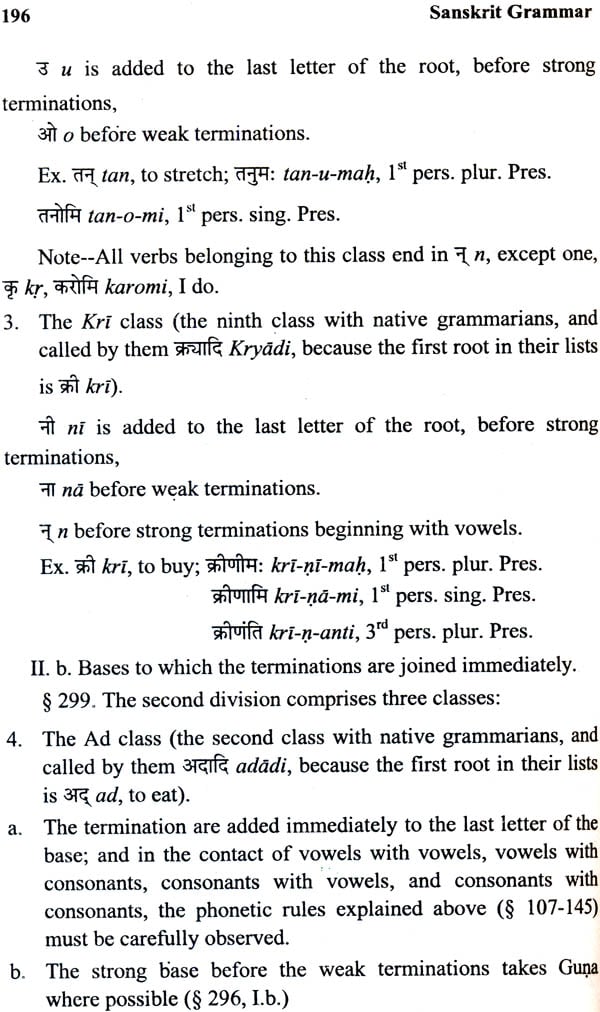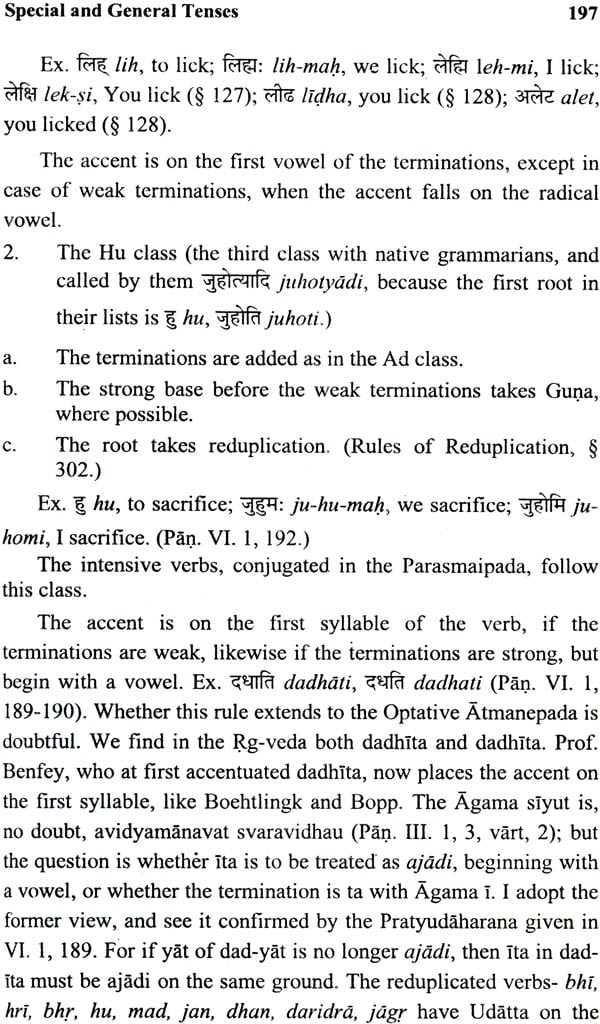
A SANSKRIT GRAMMAR (For Beginners) : Devanagari and Roman letters Throughout Revised Edition New Composed
Book Specification
| Item Code: | IDH056 |
| Author: | <a |
| Publisher: | Parimal Publication Pvt. Ltd. |
| Language: | English |
| Edition: | 2020 |
| ISBN: | 8171101821 |
| Pages: | 407 |
| Cover: | Hardcover |
| Other Details | 8.5 |
| Weight | 670 gm |
Book Description
The two principal objects which [ have kept in view while composing this grammar, have been clearness and correctness. With regard to clearness, my chief model has been the grammar of Bopp; with regard to correctness, the grammar of Colebrooke. If I may hope, without presumption, to have simplified a few of the intricacies of Sanskrit grammar which were but partially cleared up by Bopp, Benfey, Flecchia, and others, I can hardly flatter myself to have reached, with regard to correctness, the high standard of Colebrooke'a great, though unfinished work. I can only say in self-defence, that it is far more difficult to be correct on every minute point, if one endeavours to re-arrange, as I have done, the materials collected by Panini, and to adapt them to the grammatical system current in Europe, than if one follows so closely as Colebrooke, the system of native grammarians, and adopts nearly the whole of their technical terminology. The grammatical system elaborated by native grammarians is, in itself, most perfect; and those who have tested Panini's work, will readily admit that there is no grammar in any language that could vie with the wonderful mechanism of his eight books of grammatical rules. But unrivalled as that system is, it is not suited to the wants of English students, least- of all to the Wants of beginners. While availing myself therefore of the materials collected in the grammar of Panini and in later works, such as the Prakriya-Kaumudi, the Siddhanta-Kaumudt the Sarasvati Prakriya, and the Madhaviya-dhatu-vrtti, I have abstained, as much as possible, . from introducing any more of the peculiar system and of the terminology of Indian grammarians 1 than has already found admittance into our Sanskrit grammars; nay, I have frequently rejected the grammatical observations supplied ready to hand in their works, in order not to overwhelm the memory of the student with too many rules and too many exceptions. Whether I have always been successful in drawing a line between what is essential in Sanskrit grammar and what is not, I must leave to the judgement of those who enjoy the good fortune of being engaged in the practical teaching of a lanyuage the students of which may be counted no longer by tens, but by hundreds. I only wish it to be understood that where I have left out rules or exceptions, contained In other grammars, whether native or European, I have done-so after mature consideration, deliberately preferring the less complete to the more complete, but, at the same time, more bewildering statement of the anomalies of the Sanskrit language. Thus, to mention one or two cases, when giving the rules on the employment of the suffixes vat and mat (§ 187), I have left out the rule that bases ending in m, though the m be preceded by other vowels than a, always take vat instead of mat. I did so partly because there are very few bases ending in m, partly because, if a word like kim-van should occur, it would be easy to discover the reason why here too v was preferred to m, viz. in order to avoid the clashing of two m's. Again, when giving the rules on the formation of denominatives (§ 495), I passed over, for very much the same reason, the prohibition given in Pal). III. 1,8,3, viz. that bases ending in m are not allowed to form denominatives. It is true, no doubt, that the omission of such rules or exceptions may be said to involve an actual misrepresentation, and that a pupil might be misled to form such words as kim- man and kim-yati. But this cannot be avoided in an elementary grammar; and the student who is likely to come in contact with such recondite forms, will no doubt be sufficiently advanced to be able to consult for himself the rules of Panini and the explanations of his commentators
My own fear is that, in writing an elementary grammar, I have erred rather in giving too much -than in giving too little. I have therefore in the table of contents marked with an asterisk all such rules as may be safely left out in a first course of Sanskrit grammar I , and I have in different places informed the reader whether certain portions might be passed over quickly, or should be carefully committed to memory. Here and there, as for instance. in § 103, a few extracts are introduced from Panini, simply in order to give the student a foretaste of what he may expect in the elaborate works of native grammarians, while lists of verbs like those contained in § 332 or § 462 are given, as everybody will see, for the sake of reference only. The somewhat elaborate treatment of the nominal bases in I and u, from { 220 to S 226, became necessary, partly because in no grammar had the different paradigms of this class been correctly given, partly because it was impossible to bring out clearly the principle on which the peculiarities and apparent irregularities of these nouns are based without entering fully into the systematic arrangement of native grammarians. Of portions like this I will not say indeed, , but I feel that I may say, and I know that those who will take the trouble to examine the same mass of evidence which I have weighed and examined, will be the most lenient in their judgement, if hereafter they should succeed better than I have done, in unravelling the intricate argumentations of native scholars.2
But while acknowledging my obligations to the great grammarians of India, it would be ungrateful were I not to acknowledge as fully the assistance which I have derived from the works of European scholars. My first acquaintance with the elements of Sanskrit was gained from Bopp's grammar. Those only who know the works of his predecessors, of Colebrooke, Carey, Wilkins, and Forster, can appreciate the advance made by Bopp in explaining the difficulties, and in lighting up, if I may say so, the dark lanes and al\eys of the Sanskrit language. I doubt whether Sanskrit scholarship would have flourished as it has, if students had been obliged to learn their grammar from Forster or Colebrooke, and I believe that to Bopp's little grammar is due a great portion of that success which has attended the study of Sanskrit literature in Germany. Colebrooke, Carey, Wilkins, and Forster worked independently of each other. Each derived his information from native teachers and from native grammars. Among these four scholars; Wilkins seems to have been the first to compose a Sanskrit grammar, for he informs us that the first printed sheet of his work was destroyed by fire in 1795. The whole grammar, however, was not published till 1808. In the mean time Forster had finished his grammar, and had actual1y delivered his MS. to the Council of the College of Fort William in 1804. But it was not published till 1810. The first part of Colebrooke's grammar was published in 1805, and therefore stands first in point of time of publication. Unfortunately it was not finished, because the grammars of Forster and Carey were then in course of publication, and would, as Colebrooke imagined, supply the deficient part of his own. Carey's grammar was published in 1806. Among these four publications, which as first attempts at making the ancient language of India accessible to European scholars, deserve the highest credit, Colebrooke's grammar is facile princeps. It is derived at first hand from the best native grammars, and evinces a, familiarity with the most intricate problems of Hindu grammarians such as few scholars have acquired after him. No one can understand and appreciate the merits of this grammar who has not" previously acquired a knowledge of the gram- matical system of Panini, and it is a great loss to Sanskrit scholarship that so valuable a work should have remained unfinished
| Chapter-The Alphabet Page The Devanagari letters. | 1 |
| Chapter 2.- Rules of Sandhi. | 12 |
| Chapter 3.- Declension. | 83 |
| Chapter 4.- Adjectives. | 156 |
| Chapter 5.- Numerals. | 161 |
| Chapter 6.- Pronouns. | 172 |
| Chapter 7 - Conjugation. | 187 |
| Chapter 8- The ten classes. | 192 |
| Chapter 9- Augment, Reduplication, and terminations. | 199 |
| Chapter 10- General Tenses. | 216 |
| Chapter 11-intermediate i. | 221 |
| Chapter 12-Stengthening and Weakening. | 242 |
| Chapter XIII-Aorist. | 247 |
| Chapter 14- Future, conditional Periphrastic Future, and Benedictive. | 264 |
| Chapter 15 - Passive | |
| Chapter 16 - Participles, Gerunds, and infinitive. | 280 |
| Chapter 17 - Verbal Adjective. | 292 |
| Chapter 18 - Causative verbs. | 297 |
| Chapter 19 - Desiderative verbs. | 304 |
| Chapter 20 - Intensive Verbs. | 309 |
| Chapter 21- Denominative verbs. | 315 |
| Chapter 22- Prepositions and particles. | 320 |
| Chapter 23- Compound words. | 324 |
| Appendix I. | |
| List of Verbs. Page 329-385 | |
| Appendix II. |







